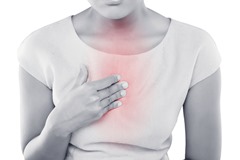Recently I read this blog post from Dr. Tori Hudson ND and she has some fantastic suggestions for those of you suffering with heartburn.
I'll share her post here:
Lifestyle Changes for Heartburn and Reflux.
Oct 18th, 2016 by Tori Hudson, N.D.
 Heartburn, often called acid indigestion is when there is a burning/acidic sensation in the chest. It is caused by a back up of acid from the stomach into the esophagus and throat. Classic symptoms are those burning sensation behind the sternum and/or in the throat, but can also be accompanied by nausea, belching, bloating. When we have one or more of these symptoms, it may not be a simply case of heartburn, which is a symptom, but rather gastroesophageal reflux disease (GERD), which is a disease that involves chronic acid regurgitation that can damage the lining of the esophagus. If one has at least two episodes of heartburn per week, that is when we need medical advice and perhaps an evaluation for GERD. GERD can also exist without any heartburn/acidic sensation at all…but perhaps a nagging cough, hoarseness, laryngitis, wheezing, postnasal drip, sinusitis, chest/ear or jaw pain, painful swallowing or a sensation in the throat.
Heartburn, often called acid indigestion is when there is a burning/acidic sensation in the chest. It is caused by a back up of acid from the stomach into the esophagus and throat. Classic symptoms are those burning sensation behind the sternum and/or in the throat, but can also be accompanied by nausea, belching, bloating. When we have one or more of these symptoms, it may not be a simply case of heartburn, which is a symptom, but rather gastroesophageal reflux disease (GERD), which is a disease that involves chronic acid regurgitation that can damage the lining of the esophagus. If one has at least two episodes of heartburn per week, that is when we need medical advice and perhaps an evaluation for GERD. GERD can also exist without any heartburn/acidic sensation at all…but perhaps a nagging cough, hoarseness, laryngitis, wheezing, postnasal drip, sinusitis, chest/ear or jaw pain, painful swallowing or a sensation in the throat.
There are natural medicine supplements, over the counter pharmaceuticals and prescription medications for heartburn and GERD. What I want to focus on here though, are the basic lifestyle changes that are fundamental to any pill, no matter the nature of the pill.
· WEIGHT-Weight management- excess weight, especially abdominal fat can contribute to heartburn or GER by putting pressure on the stomach which then pushes the contents up into the stomach. Even a gain of 10 # in women can increase the risk by 40%. Once a woman is in the category of overweight or obese, the risk of GERD symptoms doubles or triples. Losing weight can decrease symptoms.
· TIMING OF EATING-Avoid eating for 2-3 hours before bedtime. This allows time for the stomach to empty. Even before going to bed, avoid lying down after eating and avoid exercising right after eating.
· SMALLER MEALS; REDUCE FLUIDS WITH MEALS-Larger meals puts greater pressure on the lower sphincter of the stomach which then leads to a greater likelihood of back up into the esophagus.
· STOP SMOKING- Smokers have an increased risk for acid reflux due to possible relaxing effects of the smoking on the sphincter. Smoking also decreases salivary production and with less saliva, we miss out on some neutralization of acid in the stomach.
· AVOID SELECT FOODS and BEVERAGES- Spicy, fatty foods, fried foods, citrus fruits and beverages, alcohol, chocolate, milk, peppermint, coffee, tea, carbonated beverages and milk. Some relax the sphincter, some are acidic and some actually promote acid production.
· ELEVATE THE HEAD OF YOUR BED-for those who have symptoms at night or early in the morning, putting wooden blocks under the headboard to raise it 4-8 inches can help to prevent reflux. Another option is to use a foam bed wedge which elevates the upper part of the body.
· SLEEP ON LEFT SIDE- believe it or not… this could help… Our stomach bends to the left… so when you lie on the left side, a portion of the stomach is lower than the esophagus… which may help to reduce backup of food and acid into the esophagus. Every little bit can help.
· SUGARLESS GUM-chewing gum after meals can stimulate saliva production which then helps to neutralize stomach acid and soothe the lining of the esophagus. I would also mention here to choose gum wisely in terms of healthier choices for the gums and teeth. One example includes those made with xylitol.
· CHECK MEDICATIONS-some medications can actually cause or contribute to heartburn or acid reflux. Your doctor and pharmacist can be very helpful here. Possible suspects include bisphosphonates, aspirin, ibuprofen, benzodiazepines, opioid narcotics, calcium channel blockers, potassium, progestins, certain antihistamines and antispasmodics, and even peppermint based herbal products.
· AVOID TIGHT CLOTHES-tight pants at the waist, tight girdles and belts can put pressure on the stomach and can worsen reflux.
· BEND AT THE KNEES- there are many reasons to bend at the knees when lifting or picking up items from the floor due to low back care in particular… but for those individuals who may do this repetitively due to their job or activities of daily living… this may also put pressure on the stomach.
That’s it for now, in terms of lifestyle changes that serve as the basic foundation upon which to add select nutritional/botanical supplements that address both cause and provide symptom relief or over the counter or prescription medications if needed.
For regular updates on natural solutions for your health concerns, you can subscribe to Dr. Hudson's blog here.
For support for your digestive complaints, please reach out to us! We're here to help you enhance your health.
For support for your digestive complaints, please reach out to us! We're here to help you enhance your health.


